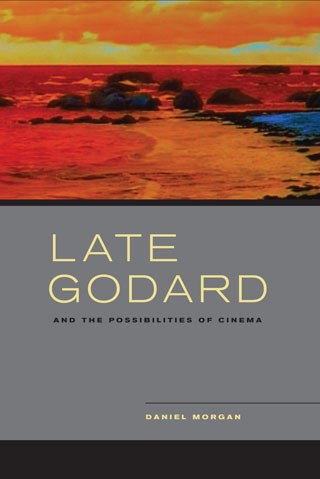First, a quick breaking from all the listing and awarding for a moment. Clayton Dillard at the House Next Door: “In his now canonical 2001 book The Language of New Media, Lev Manovich makes a connection between cinema and painting—how the kino-eye becomes the kino-brush—to explicate how digital imaging becomes an arduous process, to be carried out one frame at a time. Daniel Morgan makes a comparable claim in Late Godard and the Possibilities of Cinema, evaluating Jean-Luc Godard‘s late oeuvre as a break from a Bazinian conception of cinema (photographic realism) and, in conjunction with his embrace of video, a move toward aesthetics—a cinema oriented around the creation of images over narrative, per se. Working extensively with four Godard films (though he mentions far more) and drawing from a plethora of theoretical and philosophical lines of argumentation, Morgan’s dense analysis seeks to function as the definitive work on Godard’s purportedly ‘post-political’ foray into formalism, demonstrating that, contrary to prior critical work, Godard remains stridently political, investigating cinema as living history and consistently questioning what cinema is, was, and will become.”
More books. Gregg Barrios introduces his interview with James Franco: “His collection of short fiction, Palo Alto (2010), was praised by writers as diverse as Amy Hempel and Gary Shteyngart. Now he has published his first chapbook of poetry, as well: Strongest of the Litter (2012). The award-winning poet Frank Bidart (who advised Franco on the arrangement of the poems) calls Litter ‘a superb, touching debut.'”
Also in the Los Angeles Review of Books, Steve Erickson: “With its artlessly perfect first sentence—’They threw me off the hay truck about noon’—James M. Cain’s The Postman Always Rings Twice drew a line in the sand as defiant as any in literature since The Adventures of Huckleberry Finn.”
In other news. We’re wishing a speedy recovery, as painless as possible, to Roger Ebert.
Lists. At Film Studies for Free, Catherine Grant is polling readers: What are the best online film studies resources of 2012?
Slant presents the “25 Best Video Games of 2012.” In the Age, authors offer a few words on their favorite books of 2012. And gorilla vs. bear picks its 100 songs of 2012.
New York. At Artinfo, J. Hoberman takes us through a quick tour of Dark and Deadpan: Pop in TV and the Movies, “an ancillary time machine in the form of a curated film and video installation,” on view alongside the exhibition Sinister Pop at the Whitney through March 31.
Los Angeles. In the Times, Susan King talks with Randy Haberkamp, the Academy’s managing director for programming, education and preservation, about A Century Ago: The Films of 1912, a program screening tonight in San Rafael.
London. “We are living in a post-Photoshop era—or so Lorenzo Durantini postulates, with a wry smile.” Luke Turner for Notes on Meta Modernism: “Durantini has curated Brush It In, a group exhibition at Flowers Gallery taking its title from a colloquial expression for the act of digital manipulation using Adobe’s ubiquitous image editing software. Here, six artists have been assembled whose works engage with the pictorial tension between virtual and material editing, between photographic representation and fabrication.” On view through January 5.
And the Guardian‘s Adrian Searle delves into the Jonas Mekas retrospective at Serpentine Gallery.
Obit. “In the face of Walt Disney’s worldwide dominance throughout most of the 20th century, European animators forged their own style and content,” writes Ronald Bergan for the Guardian. “Fyodor Khitruk, who has died aged 95, was able to find new possibilities for animation in the Soviet Union, but only after the death of Joseph Stalin in 1953 and Nikita Khrushchev’s subsequent speech attacking Stalinism. The resulting ‘thaw’ was the beginning of a renaissance of Soviet animation after two decades of socialist realism and fairytales. Khitruk took his inspiration not from Disney but from the cartoons of the moribund UPA (United Productions of America) studio, set up by a breakaway group of Disney animators in 1943.”
More browsing? See Mike Everleth, Steve Greene, and John Wyver.
For news and tips throughout the day every day, follow @KeyframeDaily on Twitter and/or the RSS feed. Get Keyframe Daily in your inbox by signing in at fandor.com/daily.




